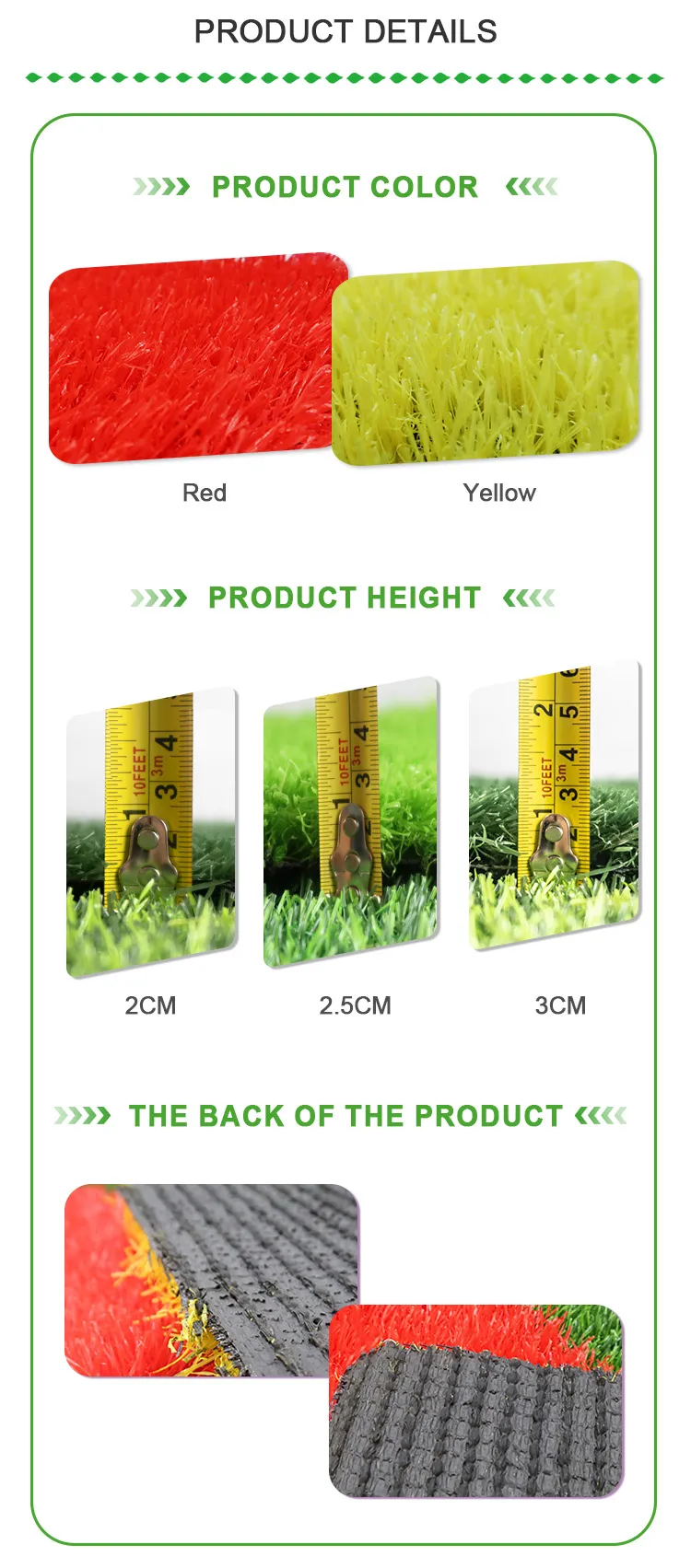
- Afrikaans
- Arabic
- Belarusian
- Bengali
- Czech
- Danish
- Dutch
- English
- Esperanto
- Estonian
- Finnish
- French
- German
- Greek
- Hindi
- Hungarian
- Icelandic
- Indonesian
- irish
- Italian
- Japanese
- kazakh
- Rwandese
- Korean
- Kyrgyz
- Lao
- Latin
- Latvian
- Malay
- Mongolian
- Myanmar
- Norwegian
- Persian
- Polish
- Portuguese
- Romanian
- Russian
- Serbian
- Spanish
- Swedish
- Tagalog
- Tajik
- Thai
- Turkish
- Turkmen
- Ukrainian
- Urdu
- Uighur
- Uzbek
- Vietnamese
sports artificial grass
Nov . 19, 2024 12:18 Back to list
The Evolution of Sports on Artificial Grass
Artificial grass, often referred to as synthetic turf, has dramatically transformed the landscape of sports fields and recreational areas over the last few decades. Initially designed as an alternative to natural grass, it has evolved into a preferred surface for various sports, enhancing the overall experience for athletes and spectators alike. This article explores the benefits, applications, and future of artificial grass in the realm of sports.
A Brief History
Artificial grass was first introduced in the 1960s, primarily used in urban areas where natural grass was challenging to maintain. The first major installation was at the Astrodome in Houston, Texas, in 1966, giving birth to the term AstroTurf. Since then, advancements in materials and technology have allowed for the development of high-quality synthetic turf that closely mimics the look and feel of natural grass.
Benefits of Artificial Grass
One of the most significant advantages of artificial grass is its low maintenance requirements. There is no need for mowing, watering, or fertilizing, allowing sports clubs and organizations to save time and resources. This is particularly important in regions facing water shortages or where maintaining natural grass is economically infeasible.
Another benefit is that artificial grass can provide a consistent playing surface, reducing the risk of uneven playing conditions. Athletes can train and compete on a uniform surface, which can lead to fewer injuries associated with natural grass, such as ankle sprains or ACL tears. Additionally, synthetic turf is designed to withstand heavy foot traffic, making it ideal for multi-sport usage in schools, colleges, and recreational facilities.
Moreover, synthetic fields can be utilized year-round, regardless of weather conditions. They drain quickly, allowing for play shortly after rain, and they do not get muddy or slippery like natural grass. This extended usage period makes artificial turf a cost-effective investment over time.
Applications in Various Sports
sports artificial grass

The versatility of artificial grass has led to its adoption across a wide array of sports. Soccer, football, field hockey, and rugby are just a few examples where synthetic turf has become the standard. It is particularly popular in youth sports, where organizations often seek ways to maximize playtime and minimize injuries.
Artificial grass is also making strides in individual sports like tennis and golf. Many tennis courts now feature artificial surfaces that allow for consistent ball bounce and reduced wear and tear, while modern putting greens utilize synthetic turf to simulate various natural grass types, providing golfers with reliable practice conditions.
Environmental Considerations
While artificial grass offers numerous advantages, it is essential to address environmental concerns linked to its production and disposal. The manufacturing process of synthetic turf involves petroleum-based products, which raises questions about sustainability. However, advancements are being made in eco-friendly materials, such as recycled plastics and organic infills, to mitigate these issues.
Furthermore, the longevity of synthetic grass means fewer replacements over time, reducing waste. Many manufacturers are now working towards recycling old turf, transforming it into new products, and ensuring that discarded synthetic grass does not end up in landfills.
The Future of Artificial Grass in Sports
The future of artificial grass in the world of sports looks promising. With ongoing innovations in technology and materials, synthetic turf will likely become even more durable and environmentally friendly. As urbanization increases and green spaces diminish, artificial grass offers a viable solution for maintaining athletic facilities without compromising quality.
In conclusion, the evolution of artificial grass has reshaped sports, providing a reliable and consistent playing surface. With its myriad benefits and growing applications, synthetic turf is set to play an increasingly critical role in the future of athletics. As we continue to explore its potential, it will be exciting to witness how artificial grass will further enhance sports experiences for athletes and fans around the world.
-
The Benefits of Artificial Turf for Indoors
NewsJul.15,2025
-
How Artificial Grass Suppliers Ensure Quality Products
NewsJul.15,2025
-
Artificial Grass and Pets: A Space for Relaxation
NewsJul.08,2025
-
Balcony & Outdoor Decoration with Artificial Grass
NewsJul.08,2025
-
Best Indoor Artificial Grass for Home
NewsJul.07,2025
-
Best Pet Turf for Dogs: Safe & Durable Artificial Grass Options
NewsJul.07,2025
Products categories









